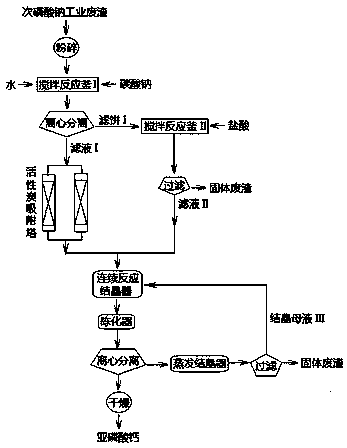Method for preparing calcium phosphite from industrial sodium hypophosphite waste residues
A technology of industrial waste residue and calcium phosphite, which is applied in the direction of phosphorous acid and phosphorus oxyacids, can solve the problems of ineffective utilization of calcium phosphite, low added value of products, and high production cost, and achieve resource utilization and production The effect of large capacity and stable product quality
- Summary
- Abstract
- Description
- Claims
- Application Information
AI Technical Summary
Problems solved by technology
Method used
Image
Examples
Embodiment
[0024] A kind of method for preparing calcium phosphite from sodium hypophosphite industrial waste residue, its specific steps are:
[0025] Step 1, crushing the industrial waste residue of sodium hypophosphite to 60-120 mesh;
[0026] Step 2. Under the conditions of 60~90°C and 200~500r / min, add the crushed waste residue, water and sodium carbonate in step 1 according to the mass ratio 1:(2~3):(0.9~1) Kettle I, stirred at constant temperature for 6~8h, centrifuged to obtain filter cake I and filtrate I;
[0027] Step 3: Add the filter cake I and hydrochloric acid with a concentration of 31wt% to the reaction kettle II under the rotational speed of 200-500r / min. The amount of hydrochloric acid added is 2-2.5 times of the quality of the filter cake I, and the constant temperature stirring reaction is 0.5~ 2h, centrifuged to obtain solid waste residue and filtrate II;
[0028] Step 4: After filtrate Ⅰ passes through the activated carbon adsorption system, it is slowly and cont...
PUM
 Login to View More
Login to View More Abstract
Description
Claims
Application Information
 Login to View More
Login to View More - R&D
- Intellectual Property
- Life Sciences
- Materials
- Tech Scout
- Unparalleled Data Quality
- Higher Quality Content
- 60% Fewer Hallucinations
Browse by: Latest US Patents, China's latest patents, Technical Efficacy Thesaurus, Application Domain, Technology Topic, Popular Technical Reports.
© 2025 PatSnap. All rights reserved.Legal|Privacy policy|Modern Slavery Act Transparency Statement|Sitemap|About US| Contact US: help@patsnap.com

